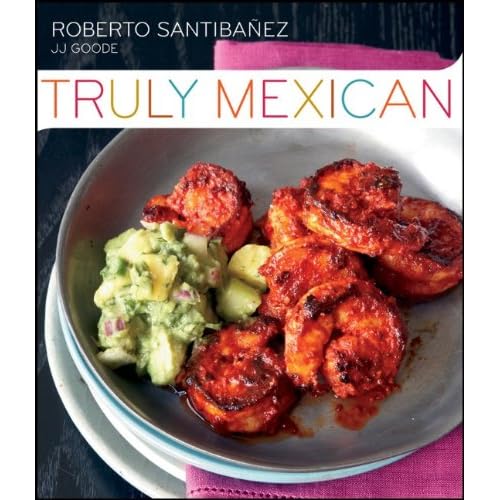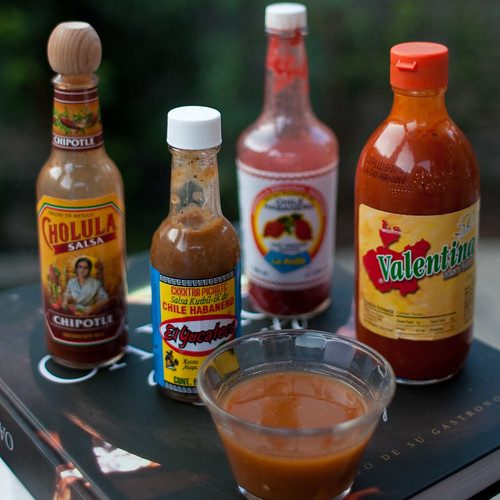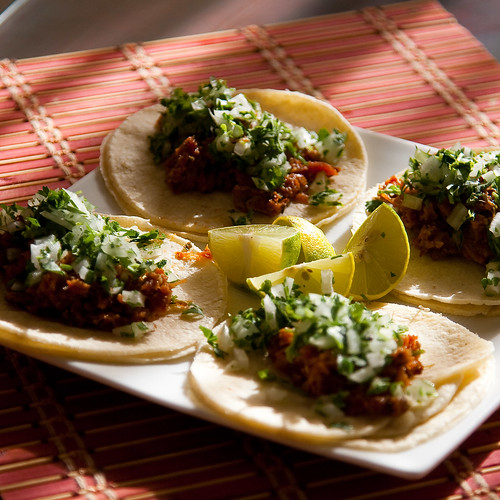Wednesday, 22 June 2011
Tuesday, 21 June 2011
Another cookbook.
I like this one an awful lot. It's approach is very different from the other books which aim to be encyclopaedias of Mexican cooking. This book has a much narrower range (and somehow seems to accomplish more as a result), he covers a large variety of salsas, followed by a number of different guacamoles, then nut thickened sauces and moles. Finally all of the various sauces are drawn on in the final chapters in a variety of meat and fish dishes.
There isn't a huge emphasis on the ethnographic matters that Diana Kennedy and Rick Bayless cover, for example there isn't a huge chapter in this book, as there is in the other two, on dishes made from corn masa. Rather he is satisfied with a brief description on the method of making corn tortillas, the salsas and moles making up the heart of the book.
There are a couple of very interesting recipes. There is a restaurant here in Monterrey which specialises in chicken tostadas smothered in crema and a very smooth guacamole containing tomatillo - there is a recipe here for this guacamole, which is something I have been meaning to try for a while now. I also have a bag of pumpkin seeds waiting in the cupboard to be included in a pumpkin seed sauce, something he has a straightforward example of.
The book is beautifully photographed by Romulo Yanes, who was a photographer for Gourmet magazine for nearly 25 years, everything looks delicious without looking manicured or overly fussed with.
Santibanez himself seems to have come from a European culinary background and is careful to spend time explaining how the techniques used are different from those which would be familiar to someone more acquainted with French or Italian cooking.
Monday, 13 June 2011
Carne en Salsa Colorada
Another approach to creating a salsa aside from those based on tomato, tomatillo or vinegar, all of which we have seen already, is to use toasted dried chiles blended with water or stock as the base and thicken the resulting mixture with a roux made of lard and masa harina. This type of salsa is generally used to braise meat as opposed to being used as a condiment.
There are a lot of variations here. Different types of dried chiles can be used, the roux can be made from masa and lard, from flour and butter, a slurry of flour can be used or the roux omitted altogether and the salsa allowed to thicken naturally.
Toasting the Chiles and the Garlic
I used a combination of chile ancho, chile passila and small chile de arbol. The ancho has a deep raisin taste, the chile de arbol resembles a dried thai birds eye chile, they round out the flavour of the passila, giving additional depth and heat.
The easiest way to toast them is on top of a hot comal. You can remove the stem, split them down the middle, open them out, remove the seeds and membrane and then toast them briefly, pushing them down with a spatula for a few moments on each side until they are fragrant but not burnt. Alternately you can lay the unopened on the comal, turning regularly and remove the stem, seeds and membranes afterwards.
I used roughly 3 anchos, a half dozen passila and another half dozen chile de arbol. After toasting the chiles are placed in a bowl of hot water to soak, weighted under a plate to keep them submerged if necessary.
As the chiles are toasting you also need to toast 3 or 4 cloves of garlic on the comal in their skins until soft.
Blending the Salsa
There a couple of divergences here. Some authors suggest that the soaking liquid is too astringent to be added to the blender. Some also suggest adding water while others use chicken stock.
Personally I don't find the soaking liquid to be a problem, however I would not add all of it to the blender lest the salsa be too loose, and I would certainly use chicken broth if some was available. Perhaps I'll just sit on the fence and suggest 3/4 of a cup of each.
Along with the liquid and the soaked chiles you will also need to add about 1/2 teaspoon each of oregano, cumin and salt. Blend everything to a fine purée.
Cooking the pork.
For the carne part of the dish I used leg of pork cut into 1cm dice. Pork shoulder would also be fine, in fact any meat which benefits from long slow moist cooking would work well.
The neat needs to be browned on all sides, when the meat is coloured remove from the pan. In a clean pot make a roux from a tablespoon of lard and a tablespoon of masa, allow to cook through and then add the salsa, straining it through a sieve to catch any pieces of chile or cumin that didn't blend fully, then add the meat and any juices to the salsa.
The whole thing is simmered slowly until the meat is tender - at least and hour.
The meat and salsa freezes well. It makes a beautiful taco, either with the meat left in cubes or pressed lightly with a masher while reheating so that is falls into strips and drinks up the salsa.
There are a lot of variations here. Different types of dried chiles can be used, the roux can be made from masa and lard, from flour and butter, a slurry of flour can be used or the roux omitted altogether and the salsa allowed to thicken naturally.
Toasting the Chiles and the Garlic
I used a combination of chile ancho, chile passila and small chile de arbol. The ancho has a deep raisin taste, the chile de arbol resembles a dried thai birds eye chile, they round out the flavour of the passila, giving additional depth and heat.
The easiest way to toast them is on top of a hot comal. You can remove the stem, split them down the middle, open them out, remove the seeds and membrane and then toast them briefly, pushing them down with a spatula for a few moments on each side until they are fragrant but not burnt. Alternately you can lay the unopened on the comal, turning regularly and remove the stem, seeds and membranes afterwards.
I used roughly 3 anchos, a half dozen passila and another half dozen chile de arbol. After toasting the chiles are placed in a bowl of hot water to soak, weighted under a plate to keep them submerged if necessary.
As the chiles are toasting you also need to toast 3 or 4 cloves of garlic on the comal in their skins until soft.
Blending the Salsa
There a couple of divergences here. Some authors suggest that the soaking liquid is too astringent to be added to the blender. Some also suggest adding water while others use chicken stock.
Personally I don't find the soaking liquid to be a problem, however I would not add all of it to the blender lest the salsa be too loose, and I would certainly use chicken broth if some was available. Perhaps I'll just sit on the fence and suggest 3/4 of a cup of each.
Along with the liquid and the soaked chiles you will also need to add about 1/2 teaspoon each of oregano, cumin and salt. Blend everything to a fine purée.
Cooking the pork.
For the carne part of the dish I used leg of pork cut into 1cm dice. Pork shoulder would also be fine, in fact any meat which benefits from long slow moist cooking would work well.
The neat needs to be browned on all sides, when the meat is coloured remove from the pan. In a clean pot make a roux from a tablespoon of lard and a tablespoon of masa, allow to cook through and then add the salsa, straining it through a sieve to catch any pieces of chile or cumin that didn't blend fully, then add the meat and any juices to the salsa.
The whole thing is simmered slowly until the meat is tender - at least and hour.
The meat and salsa freezes well. It makes a beautiful taco, either with the meat left in cubes or pressed lightly with a masher while reheating so that is falls into strips and drinks up the salsa.
Saturday, 11 June 2011
Habanero Salsa
My tolerance for chile, and habanero in particular has increased a lot over the past 18 months. This is a good thing. Habaneros, though hot, have a unique fruity taste, quite different from the crisp clear heat of a serrano, it is a much more interesting taste - provided you can stand the heat!
This salsa is fairly hot. It takes a different approach from the tomato or tomatillo based salsas we have seen already in that it is a vinegar based salsa. There are very few ingredients; chiles, water, vinegar, onion, garlic and salt.
I was a little careless in measuring the quantities, in truth it was just an initial exploration and I was surprised it turned out so well. The quantities here should be taken as a guide rather than a blueprint.
To temper the heat slightly I used some serrano along with the habanero, so the final list of ingredients was:
1/2 to 3/4 cup of water
An equal quantity of red wine vinegar
2 chocolate habaneros (though orange or green would be fine)
2 cloves of roasted garlic
2 roughly chopped serranos
A couple of slices of onion
A good helping of salt.
Everything was added to a small saucepan and simmered for 10 minutes or so. You need a roughly equal quantity of water and vinegar. Cider vinegar would be more authentic but red wine vinegar was what I had available, and considering the quantity of chile I'm not sure it would be possible to tell the difference anyway.
The poached ingredients were blended until smooth and the seasoning adjusted. You should end up with about a cup of a loose salsa with the consistency of pouring cream.
I find the sauce to be hot without being totally overpowering, it keeps the nice fruity floral taste of habanero. It's certainly ho enough to get your attention but it doesn't obliterate whatever it's eaten with and it is certainly much less spicy than some of the bottled habanero salsas you can by in the shops here.
This salsa is fairly hot. It takes a different approach from the tomato or tomatillo based salsas we have seen already in that it is a vinegar based salsa. There are very few ingredients; chiles, water, vinegar, onion, garlic and salt.
I was a little careless in measuring the quantities, in truth it was just an initial exploration and I was surprised it turned out so well. The quantities here should be taken as a guide rather than a blueprint.
To temper the heat slightly I used some serrano along with the habanero, so the final list of ingredients was:
1/2 to 3/4 cup of water
An equal quantity of red wine vinegar
2 chocolate habaneros (though orange or green would be fine)
2 cloves of roasted garlic
2 roughly chopped serranos
A couple of slices of onion
A good helping of salt.
Everything was added to a small saucepan and simmered for 10 minutes or so. You need a roughly equal quantity of water and vinegar. Cider vinegar would be more authentic but red wine vinegar was what I had available, and considering the quantity of chile I'm not sure it would be possible to tell the difference anyway.
The poached ingredients were blended until smooth and the seasoning adjusted. You should end up with about a cup of a loose salsa with the consistency of pouring cream.
I find the sauce to be hot without being totally overpowering, it keeps the nice fruity floral taste of habanero. It's certainly ho enough to get your attention but it doesn't obliterate whatever it's eaten with and it is certainly much less spicy than some of the bottled habanero salsas you can by in the shops here.
Wednesday, 1 June 2011
Subscribe to:
Posts (Atom)



